TEXAS INSTRUMENTS THS3110, THS3111 Technical data
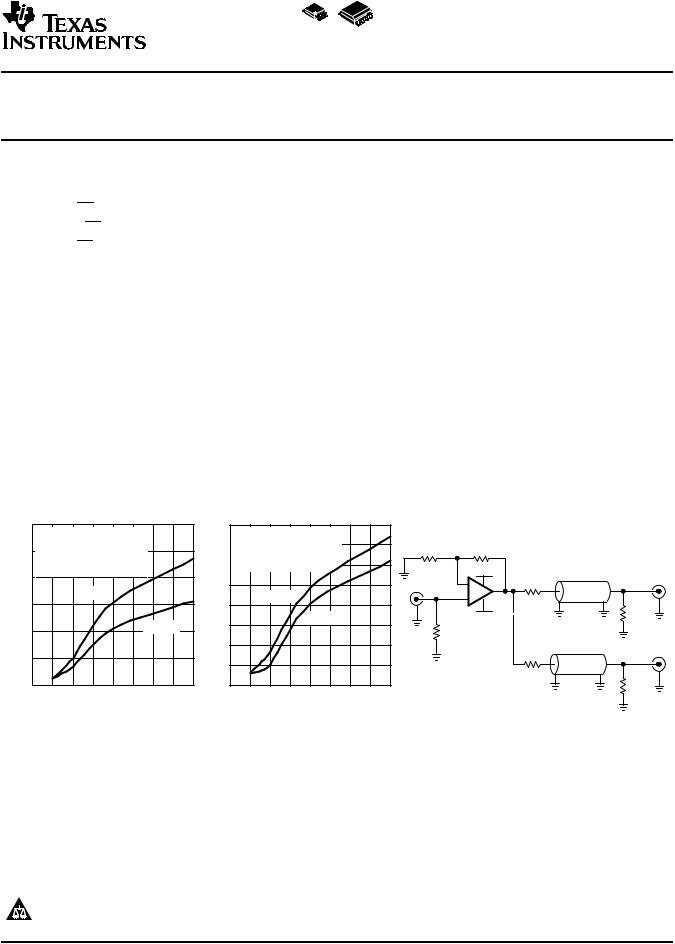
THS3110
THS3110, THS3111
www.ti.com |
SLOS422A –SEPTEMBER 2003 –REVISED NOVEMBER 2003 |
|
LOW-NOISE, HIGH-VOLTAGE, CURRENT-FEEDBACK,
OPERATIONAL AMPLIFIERS
FEATURES
·Low Noise
–2 pA/ÖHz Noninverting Current Noise
–10 pA/ÖHz Inverting Current Noise
–3 nV/ÖHz Voltage Noise
·High Output Current Drive: 260 mA
·High Slew Rate: 1300 V/µs (RL = 100 W,
VO = 8 VPP)
·Wide Bandwidth: 90 MHz (G = 2, RL = 100 W)
·Wide Supply Range: ±5 V to ±15 V
·Power-Down Feature: (THS3110 Only)
APPLICATIONS
·Video Distribution
·Power FET Driver
·Pin Driver
·Capacitive Load Driver
DESCRIPTION
The THS3110 and THS3111 are low-noise, high-voltage, current-feedback amplifiers designed to operate over a wide supply range of ±5 V to ±15 V for today'shigh performance applications.
The THS3110 features a power-down pin (PD) that puts the amplifier in low power standby mode, and lowers the quiescent current from 4.8 mA to 270 µA.
These amplifiers provide well-regulated ac performance characteristics. The unity gain bandwidth of 100 MHz allows for good distortion characteristics below 10 MHz. Coupled with high 1300-V/µs slew rate, the THS3110 and THS3111 amplifiers allow for high output voltage swings at high frequencies.
The THS3110 and THS3111 are offered in a 8-pin SOIC (D), and the 8-pin MSOP (DGN) packages with PowerPAD™.
DIFFERENTIAL GAIN |
DIFFERENTIAL PHASE |
vs |
vs |
NUMBER OF LOADS |
NUMBER OF LOADS |
|
0.3 |
Gain = 2, |
|
|
|
|
|
|
|
0.4 |
Gain = 2, |
|
|
|
|
|
|
|
VIDEO DISTRIBUTION AMPLIFIER APPLICATION |
||||
|
|
|
|
|
|
|
|
|
|
|
|
|
|
|
|
|
|||||||
|
|
RF = 1 k |
Ω |
|
|
|
|
|
|
|
0.35 |
R = 1 kΩ, |
|
|
|
|
|
|
|
|
|
|
|
|
|
, |
|
|
|
|
|
|
|
F |
|
|
|
|
|
|
|
1 kΩ |
1 kΩ |
|
|
||
|
0.25 |
VS = ±15 V, |
|
|
|
|
|
|
|
|
VS = ±15 V, |
|
|
|
|
|
|
|
|
||||
|
|
40 IRE − NTSC and PAL, |
|
|
|
|
|
|
40 IRE − NTSC and PAL, |
|
|
|
|
|
|
|
|
||||||
|
|
|
|
|
|
|
0.3 |
Worst Case ±100 IRE Ramp |
|
|
|
|
15 V |
|
|
||||||||
% |
|
Worst Case ±100 IRE Ramp |
|
|
|
|
|
|
|
|
75-Ω Transmission Line |
VO(1) |
|||||||||||
0.2 |
|
|
|
|
|
|
|
|
|
|
|
|
|
|
|||||||||
− |
|
|
|
|
|
|
|
|
− |
0.25 |
|
|
|
|
|
|
|
|
|
− |
|
||
GainDifferential |
|
|
|
PAL |
|
|
|
|
|
PhaseDifferential |
|
|
|
|
|
|
|
|
|
75 Ω |
VO(n) |
||
|
|
|
|
|
|
|
|
|
|
|
PAL |
|
|
|
|
VI |
|
+ |
|||||
|
|
|
|
|
|
|
|
|
|
|
|
|
|
|
|
|
|
75 Ω |
|
||||
|
0.15 |
|
|
|
|
|
|
|
|
|
0.2 |
|
|
|
|
|
|
|
|
||||
|
|
|
|
|
|
|
|
|
|
|
|
|
|
|
|
|
|
|
|
||||
|
|
|
|
|
|
|
|
|
|
|
0.15 |
|
|
|
NTSC |
|
|
|
|
−15 V |
|
75 Ω |
|
|
0.1 |
|
|
|
|
|
NTSC |
|
|
|
|
|
|
|
|
|
|
|
n Lines |
||||
|
|
|
|
|
|
|
|
|
|
|
|
|
|
|
|
|
75 Ω |
|
|||||
|
|
|
|
|
|
|
|
|
|
|
|
|
|
|
|
|
|
|
|
|
|
|
|
|
|
|
|
|
|
|
|
|
|
|
0.1 |
|
|
|
|
|
|
|
|
|
|
|
|
|
0.05 |
|
|
|
|
|
|
|
|
|
0.05 |
|
|
|
|
|
|
|
|
|
|
|
|
|
|
|
|
|
|
|
|
|
|
|
|
|
|
|
|
|
|
|
|
|
|
|
|
|
0 |
|
|
|
|
|
|
|
|
|
0 |
|
|
|
|
|
|
|
|
|
|
|
|
|
0 |
1 |
2 |
3 |
4 |
5 |
6 |
7 |
8 |
|
0 |
1 |
2 |
3 |
4 |
5 |
6 |
7 |
8 |
|
|
|
75 Ω |
|
|
|
|
|
|
|
|
|
|
|
|
|
|
||||||||||
|
|
Number of 150 Ω Loads |
|
|
|
|
|
Number of 150 Ω Loads |
|
|
|
|
|
|
|||||||||
Please be aware that an important notice concerning availability, standard warranty, and use in critical applications of Texas Instruments semiconductor products and disclaimers thereto appears at the end of this data sheet.
PowerPAD is a trademark of Texas Instruments.
PRODUCTION DATA information is current as of publication date. |
Copyright © 2003, Texas Instruments Incorporated |
Products conform to specifications per the terms of the Texas |
|
Instruments standard warranty. Production processing does not |
|
necessarily include testing of all parameters. |
|

THS3110, THS3111
www.ti.com
SLOS422A –SEPTEMBER 2003 –REVISED NOVEMBER 2003
This integrated circuit can be damaged by ESD. Texas Instruments recommends that all integrated circuits be handled with appropriate precautions. Failure to observe proper handling procedures and installation procedures can cause damage.
TOP VIEW |
|
|
|
|
|
|
|
|
|
|
D, DGN |
TOP VIEW |
|
|
|
|
|
|
|
|
D, DGN |
|||||||||||
|
|
|
THS3110 |
|
|
|
|
|
|
|
|
|
THS3111 |
|
|
|
||||||||||||||||
REF |
|
|
|
|
|
|
|
|
|
|
|
|
|
|
|
|
NC |
|
|
|
|
|
|
|
|
|
|
|
|
NC |
||
|
|
1 |
|
|
|
|
|
|
|
8 |
|
|
|
PD |
|
|
|
1 |
|
|
|
|
|
8 |
|
|
||||||
VIN− |
|
|
2 |
|
|
|
|
|
|
|
7 |
|
|
|
VS+ |
VIN − |
|
|
|
2 |
|
|
|
|
|
7 |
|
|
VS+ |
|||
|
|
|
|
|
|
|
|
|
|
|
|
|
|
|
|
|
|
|
||||||||||||||
VIN+ |
|
|
3 |
|
|
|
|
|
|
|
|
6 |
|
|
|
VOUT |
VIN + |
|
|
|
3 |
|
|
|
|
|
|
6 |
|
|
VOUT |
|
|
|
|
|
|
|
|
|
|
|
|
|
|
|
|
|
|||||||||||||||||
VS− |
|
|
4 |
|
|
|
|
|
|
|
5 |
|
|
|
NC |
VS− |
|
|
|
4 |
|
|
|
|
|
5 |
|
|
NC |
|||
|
|
|
|
|
|
|
|
|
||||||||||||||||||||||||
NC = No Internal Connection |
NC = No Internal Connection |
|||||||||||||||||||||||||||||||
|
|
|
|
|
|
|
|
|
|
|
|
|
|
|
|
|
|
|
|
|
|
|
|
|
|
|
|
|
|
|
|
|
Note: The device with the power down option defaults to the ON state if no signal is applied to the PD pin. Additionallly, the REF pin functional range is from VS− to (VS+ − 4 V).
AVAILABLE OPTIONS
TA |
|
PACKAGED DEVICE |
|
|
PLASTIC SMALL OUTLINE SOIC (D) |
PLASTIC MSOP (DGN)(1) (2) |
SYMBOL |
||
|
||||
0°C to 70°C |
THS3110CD |
THS3110CDGN |
BJB |
|
THS3110CDR |
THS3110CDGNR |
|||
|
|
|||
-40°C to 85°C |
THS3110ID |
THS3110IDGN |
BIR |
|
THS3110IDR |
THS3110IDGNR |
|||
|
|
|||
0°C to 70°C |
THS3111CD |
THS3111CDGN |
BJA |
|
THS3111CDR |
THS3111CDGNR |
|||
|
|
|||
-40°C to 85°C |
THS3111ID |
THS3111IDGN |
BIS |
|
THS3111IDR |
THS3111IDGNR |
|||
|
|
(1)Available in tape and reel. The R suffix standard quantity is 2500 (e.g. THS3110CDGNR).
(2)The PowerPAD is electrically isolated from all other pins.
DISSIPATION RATING TABLE
|
|
|
|
POWER RATING |
PACKAGE |
Θ (°C/W) |
Θ (°C/W) |
|
TJ = 125°C |
|
JC |
JA |
TA = 25°C |
TA = 85°C |
|
|
|
||
D-8(1) |
38.3 |
95 |
1.05 W |
421 mW |
DGN-8(2) |
4.7 |
58.4 |
1.71 W |
685 mW |
(1)This data was taken using the JEDEC standard low-K test PCB. For the JEDEC proposed high-K test PCB, the ΘJA is 95°C/W with power rating at TA = 25°C of 1.05 W.
(2)This data was taken using 2 oz. trace and copper pad that is soldered directly to a 3 inch x 3 inch PCB. For further information, refer to the Application Informationsection of this data sheet.
2

THS3110, THS3111
www.ti.com
SLOS422A –SEPTEMBER 2003 –REVISED NOVEMBER 2003
RECOMMENDED OPERATING CONDITIONS
|
|
MIN |
NOM |
MAX |
UNIT |
Supply voltage |
Dual supply |
±5 |
|
±15 |
V |
Single supply |
10 |
|
30 |
||
|
|
|
|||
Operating free-air temperature, TA |
Commercial |
0 |
|
70 |
|
Industrial |
-40 |
|
85 |
|
|
|
|
°C |
|||
Operating junction temperature, continuous operating temperature, TJ |
-40 |
|
125 |
||
|
|
||||
Normal storage temperature, Tstg |
|
-40 |
|
85 |
|
ABSOLUTE MAXIMUM RATINGS
over operating free-air temperature (unless otherwise noted)(1)
|
|
UNIT |
|
Supply voltage, VS- to VS+ |
|
33 V |
|
Input voltage, VI |
|
± VS |
|
Differential input voltage, VID |
|
± 4 V |
|
Output current, I (2) |
|
300 mA |
|
O |
|
|
|
Continuous power dissipation |
|
See Dissipation Ratings Table |
|
Maximum junction temperature, T |
(3) |
150°C |
|
J |
|
||
Maximum junction temperature, continuous operation, long term reliability, T (4) |
125°C |
||
|
J |
|
|
Operating free-air temperature, TA |
Commercial |
0°C to 70°C |
|
Industrial |
-40°C to 85°C |
||
|
|||
Storage temperature, Tstg |
|
-65°C to 125°C |
|
Lead temperature 1,6 mm (1/16 inch) from case for 10 seconds |
300°C |
||
ESD ratings: |
|
|
|
HBM |
|
900 |
|
CDM |
|
1500 |
|
MM |
|
200 |
|
(1)Stresses beyond those listed under absolute maximum ratings may cause permanent damage to the device. These are stress ratings only, and functional operation of the device at these or any other conditions beyond those indicated under,, recommended operating conditions” is not implied. Exposure to absolute-maximum-rated conditions for extended periods may affect device reliability.
(2)The THS3110 and THS3111 may incorporate a PowerPAD™ on the underside of the chip. This acts as a heatsink and must be connected to a thermally dissipating plane for proper power dissipation. Failure to do so may result in exceeding the maximum junction temperature which could permanently damage the device. See TI Technical Brief SLMA002 for more information about utilizing the PowerPAD™ thermally enhanced package.
(3)The absolute maximum temperature under any condition is limited by the constraints of the silicon process.
(4)The maximum junction temperature for continuous operation is limited by package constraints. Operation above this temperature may result in reduced reliability and/or lifetime of the device.
3
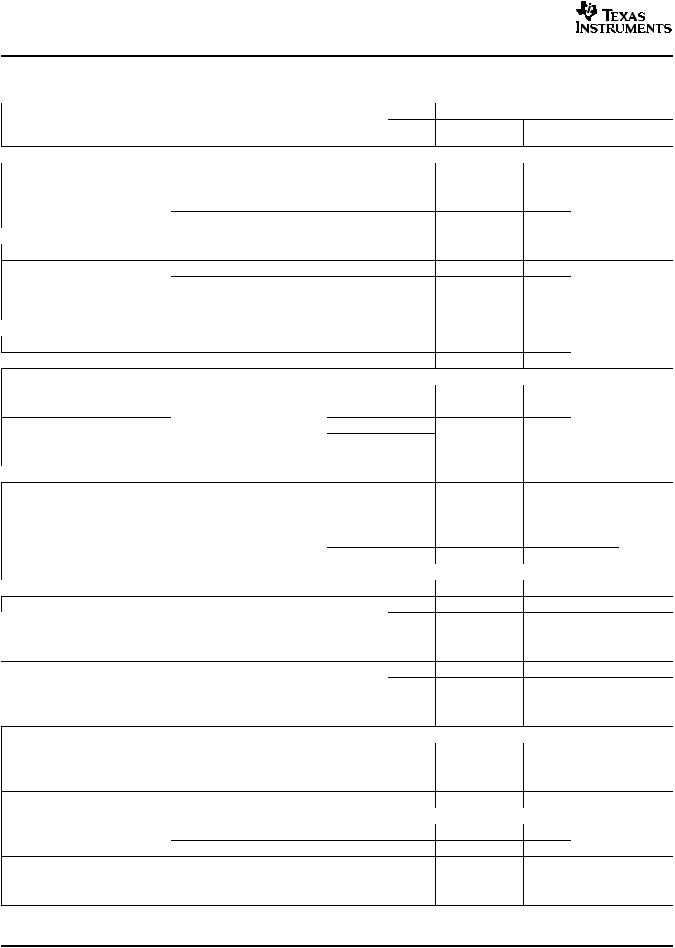
THS3110, THS3111
www.ti.com
SLOS422A –SEPTEMBER 2003 –REVISED NOVEMBER 2003
ELECTRICAL CHARACTERISTICS
VS = ±15 V, RF = 1 k Ω,RL = 100 Ω, and G = 2 (unless otherwise noted)
PARAMETER
 AC PERFORMANCE
AC PERFORMANCE
 Small-signal bandwidth, -3 dB
Small-signal bandwidth, -3 dB
 0.1 dB bandwidth flatness Large-signal bandwidth
0.1 dB bandwidth flatness Large-signal bandwidth
 Slew rate (25% to 75% level)
Slew rate (25% to 75% level)
Slew rate
 Rise and fall time
Rise and fall time
Settling time to 0.1%
 Settling time to 0.01%
Settling time to 0.01%
Harmonic distortion
 2nd Harmonic distortion
2nd Harmonic distortion
 3rd Harmonic distortion
3rd Harmonic distortion
Input voltage noise
 Noninverting input current noise Inverting input current noise
Noninverting input current noise Inverting input current noise
 Differential gain
Differential gain
 Differential phase
Differential phase
DC PERFORMANCE
 Transimpedance
Transimpedance
Input offset voltage
Average offset voltage drift  Noninverting input bias current
Noninverting input bias current
Average bias current drift  Inverting input bias current
Inverting input bias current
Average bias current drift  Input offset current
Input offset current
Average offset current drift
INPUT CHARACTERISTICS
|
TYP |
|
OVER TEMPERATURE |
|
||
TEST CONDITIONS |
25°C |
25°C |
0°C to |
-40°C to |
UNIT |
MIN/TYP/ |
|
70°C |
85°C |
MAX |
|||
|
|
|
|
|||
G = 1, RF = 1.5 kW, VO = 200 mVPP |
100 |
|
|
|
|
|
G = 2, RF = 1 kW, VO = 200 mVPP |
90 |
|
|
|
|
|
G = 5, RF = 806 W, VO = 200 mVPP |
87 |
|
|
|
MHz |
TYP |
G = 10, RF = 604 W, VO = 200 mVPP |
66 |
|
|
|
||
|
|
|
|
|
||
G = 2, RF = 1.15 kW, VO = 200 mVPP |
45 |
|
|
|
|
|
G = 5, RF = 806 W , VO = 4 VPP |
95 |
|
|
|
|
|
G = 1, VO = 4-V step, RF = 1.5 kW |
800 |
|
|
|
V/µs |
TYP |
G = 2, VO = 8-V step, RF = 1 kW |
1300 |
|
|
|
||
|
|
|
|
|
||
Recommended maximum SR for repetitive signals(1)
 G = -5, VO = 10-V step, RF = 806 W
G = -5, VO = 10-V step, RF = 806 W  G = -2, VO = 2 VPP step
G = -2, VO = 2 VPP step
G = -2, VO = 2 VPP step
G = 2,
RF = 1 kW , VO = 2 VPP, f = 10 MHz
 f > 20 kHz
f > 20 kHz  f > 20 kHz
f > 20 kHz  f > 20 kHz
f > 20 kHz
G = 2,
 RL = 150 W,
RL = 150 W,
RF = 1 kW
 VO = ±3.75 V, Gain = 1
VO = ±3.75 V, Gain = 1

 VCM = 0 V
VCM = 0 V

 VCM = 0 V
VCM = 0 V

 VCM = 0 V
VCM = 0 V

 VCM = 0 V
VCM = 0 V
|
900 |
|
8 |
|
27 |
|
250 |
RL = 100 W |
52 |
RL = 1 kW |
53 |
RL = 100 W |
48 |
RL = 1 kW |
68 |
|
3 |
|
2 |
|
10 |
NTSC |
0.011% |
PAL |
0.013% |
NTSC |
0.029° |
PAL |
0.033° |
V/µs MAX
ns TYP
ns TYP
dBc |
TYP |
nV / ÖHz |
TYP |
pA / ÖHz |
TYP |
pA / ÖHz |
TYP |
|
TYP |
1.6 |
1 |
0.7 |
0.7 |
MW |
MIN |
1.5 |
6 |
8 |
8 |
mV |
MAX |
|
|
±10 |
±10 |
µV/°C |
TYP |
1 |
4 |
6 |
6 |
µA |
MAX |
|
|
±10 |
±10 |
nA/°C |
TYP |
1.5 |
15 |
20 |
20 |
µA |
MAX |
|
|
±10 |
±10 |
nA/°C |
TYP |
2.5 |
15 |
20 |
20 |
µA |
MAX |
|
|
±30 |
±30 |
nA/°C |
TYP |
Input common-mode voltage range |
|
±13.3 |
±13 |
±12.5 |
±12.5 |
V |
MIN |
|
Common-mode rejection ratio |
VCM = ±12.5 V |
68 |
62 |
60 |
60 |
dB |
MIN |
|
Noninverting input resistance |
|
41 |
|
|
|
MW |
TYP |
|
Noninverting input capacitance |
|
0.4 |
|
|
|
pF |
TYP |
|
OUTPUT CHARACTERISTICS |
|
|
|
|
|
|
|
|
Output voltage swing |
RL = 1 kW |
±13.5 |
±13 |
±12.5 |
±12.5 |
V |
MIN |
|
RL = 100 W |
±13.4 |
±12.5 |
±12 |
±12 |
||||
|
|
|
||||||
Output current (sourcing) |
RL = 25 W |
260 |
200 |
175 |
175 |
mA |
MIN |
|
Output current (sinking) |
RL = 25 W |
260 |
200 |
175 |
175 |
mA |
MIN |
|
Output impedance |
f = 1 MHz, Closed loop |
0.15 |
|
|
|
W |
TYP |
(1) For more information, see the Application Information section of this data sheet.
4
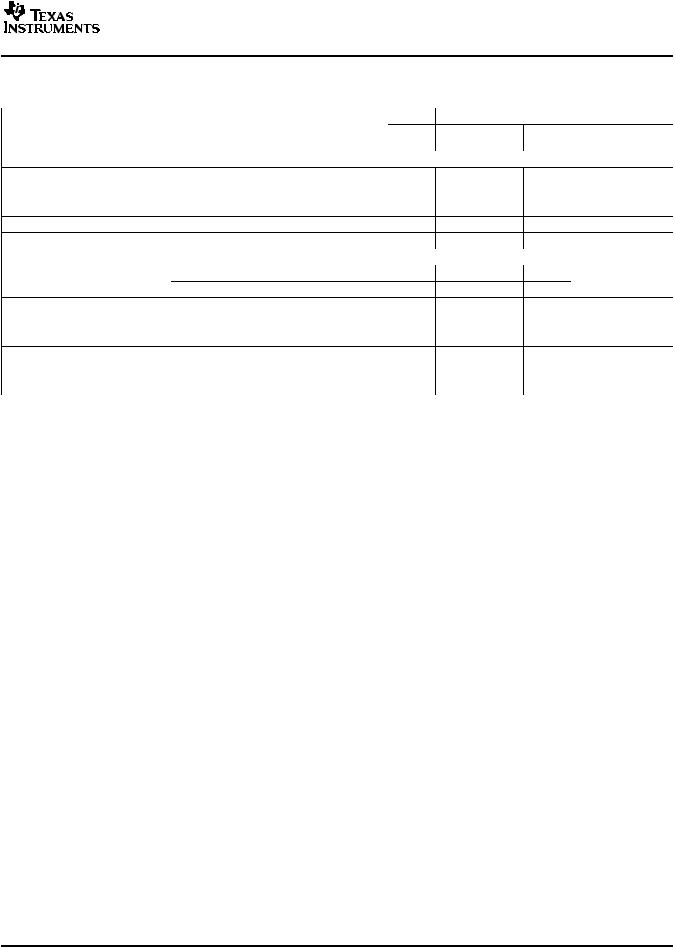
THS3110, THS3111
www.ti.com
SLOS422A –SEPTEMBER 2003 –REVISED NOVEMBER 2003
ELECTRICAL CHARACTERISTICS (continued)
VS = ±15 V, RF = 1 k Ω,RL = 100 Ω, and G = 2 (unless otherwise noted)
|
|
TYP |
|
OVER TEMPERATURE |
|
||
PARAMETER |
TEST CONDITIONS |
25°C |
25°C |
0°C to |
-40°C to |
UNIT |
MIN/TYP/ |
|
|
70°C |
85°C |
MAX |
|||
|
|
|
|
|
|||
POWER SUPPLY |
|
|
|
|
|
|
|
Specified operating voltage |
|
±15 |
±16 |
±16 |
±16 |
V |
MAX |
Maximum quiescent current |
|
4.8 |
6.5 |
7.5 |
7.5 |
mA |
MAX |
Minimum quiescent current |
|
4.8 |
3.8 |
2.5 |
2.5 |
mA |
MIN |
Power supply rejection (+PSRR) |
VS+ = 15.5 V to 14.5 V, VS- = 15 V |
83 |
75 |
70 |
70 |
dB |
MIN |
Power supply rejection (-PSRR) |
VS+ = 15 V, VS- = -15.5 V to -14.5 V |
78 |
70 |
66 |
66 |
dB |
MIN |
POWER-DOWN CHARACTERISTICS |
|
|
|
|
|
|
|
Power-down voltage level |
Enable, REF = 0 V |
£ 0.8 |
|
|
|
V |
MAX |
Power-down , REF = 0 V |
³ 2 |
|
|
|
|||
|
|
|
|
|
|
||
Power-down quiescent current |
PD = 0V |
270 |
450 |
500 |
500 |
µA |
MAX |
VPD quiescent current |
VPD = 0 V, REF = 0 V, |
11 |
|
|
|
µA |
TYP |
VPD = 3.3 V, REF = 0 V |
11 |
|
|
|
|||
|
|
|
|
|
|
||
Turnon time delay |
90% of final value |
4 |
|
|
|
µs |
TYP |
Turnoff time delay |
10% of final value |
6 |
|
|
|
||
|
|
|
|
|
|||
Input impedance |
|
3.4 || 1.7 |
|
|
|
kW || pF |
TYP |
5
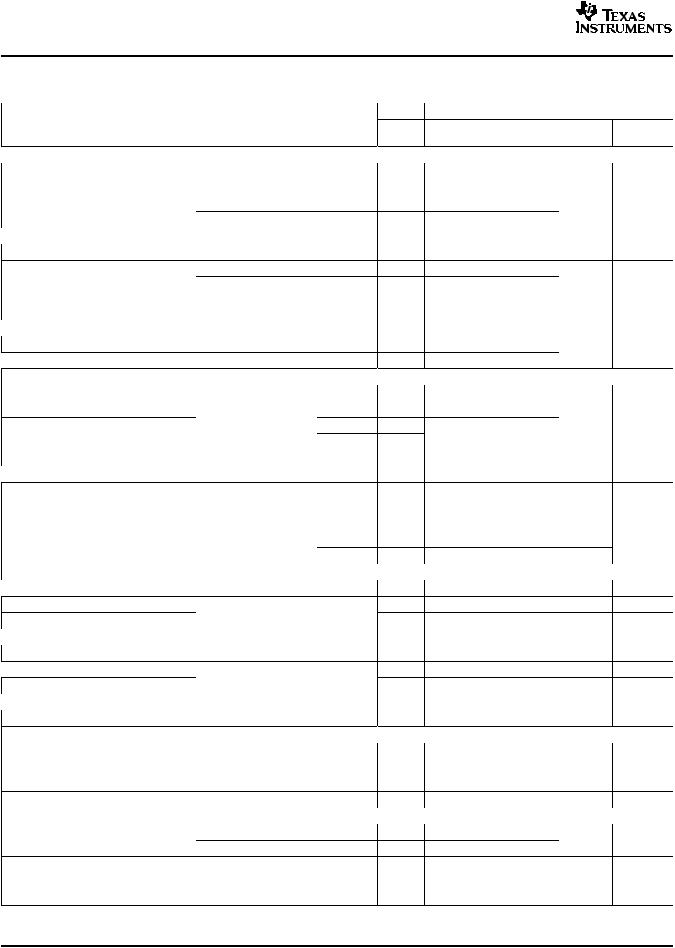
THS3110, THS3111
SLOS422A –SEPTEMBER 2003 –REVISED NOVEMBER 2003
ELECTRICAL CHARACTERISTICS
VS = ±5 V, RF = 1.15 Ω, RL = 100 Ω, and G = 2 (unless otherwise noted)
PARAMETER
 AC PERFORMANCE
AC PERFORMANCE
 Small-signal bandwidth, -3 dB
Small-signal bandwidth, -3 dB
 0.1 dB bandwidth flatness Large-signal bandwidth
0.1 dB bandwidth flatness Large-signal bandwidth
 Slew rate (25% to 75% level)
Slew rate (25% to 75% level)
Slew rate
 Rise and fall time
Rise and fall time
Settling time to 0.1%
 Settling time to 0.01%
Settling time to 0.01%
Harmonic distortion
 2nd Harmonic distortion
2nd Harmonic distortion
 3rd Harmonic distortion
3rd Harmonic distortion
Input voltage noise
 Noninverting input current noise Inverting input current noise
Noninverting input current noise Inverting input current noise
 Differential gain
Differential gain
 Differential phase
Differential phase
DC PERFORMANCE
 Transimpedance
Transimpedance
Input offset voltage
Average offset voltage drift
 Noninverting input bias current
Noninverting input bias current
Average bias current drift
 Inverting input bias current
Inverting input bias current
Average bias current drift
 Input offset current
Input offset current
Average offset current drift
INPUT CHARACTERISTICS
|
|
TYP |
|
TEST CONDITIONS |
25°C |
25°C |
|
|
|
||
G = 1, RF = 1.5 kW, VO = 200 mVPP |
85 |
|
|
G = 2, RF = 1.15 kW, VO = 200 mVPP |
78 |
|
|
G = 5, RF = 806 W, VO = 200 mVPP |
80 |
|
|
G = 10, RF = 604 W, VO = 200 mVPP |
60 |
|
|
G = 2, RF = 1.15 kW, VO = 200 mVPP |
15 |
|
|
G = 5, RF = 806 W , VO = 4 VPP |
80 |
|
|
G = 1, VO= 4-V step, RF = 1.5 kW |
640 |
|
|
G = 2, VO= 4-V step, RF = 1 kW |
700 |
|
|
Recommended maximum SR for |
900 |
|
|
repetitive signals(1) |
|
|
|
|
|
|
|
G = -5, VO = 5-V step, RF = 806W |
7 |
|
|
G = -2, VO = 2 VPP step |
|
20 |
|
G = -2, VO = 2 VPP step |
|
200 |
|
G = 2, |
RL = 100W |
55 |
|
RL = 1 kW |
56 |
|
|
RF = 1 kW , |
|
||
VO = 2 VPP, |
RL = 100W |
45 |
|
f = 10 MHz |
RL = 1 kW |
62 |
|
|
|
||
f > 20 kHz |
|
3 |
|
f > 20 kHz |
|
2 |
|
f > 20 kHz |
|
10 |
|
|
NTSC |
0.011% |
|
G = 2, |
PAL |
0.015% |
|
RL = 150 W, |
NTSC |
0.020° |
|
RF = 1 kW |
|
||
|
PAL |
0.033° |
|
VO = ±1.25 V, Gain = 1 |
|
1.6 |
1 |
VCM = 0 V |
|
3 |
6 |
|
|
|
|
VCM = 0 V |
|
1 |
4 |
|
|
|
|
VCM = 0 V |
|
1 |
8 |
|
|
|
|
VCM = 0 V |
|
1 |
6 |
|
|
|
|
Input common-mode voltage range |
|
±3.2 |
±2.9 |
|
Common-mode rejection ratio |
VCM = ±2.5 V |
65 |
62 |
|
Noninverting input resistance |
|
35 |
|
|
Noninverting input capacitance |
|
0.5 |
|
|
OUTPUT CHARACTERISTICS |
|
|
|
|
Output voltage swing |
RL = 1 kW |
±4 |
±3.8 |
|
RL = 100 W |
±3.8 |
±3.7 |
||
|
||||
Output current (sourcing) |
RL = 10 W |
220 |
150 |
|
Output current (sinking) |
RL = 10 W |
220 |
150 |
|
Output impedance |
f = 1 MHz, Closed loop |
0.15 |
|
(1) For more information, see the Application Information section of this data sheet.
6
www.ti.com
OVER TEMPERATURE
0°C to |
-40°C to |
70°C |
85°C |
0.7 |
0.7 |
8 |
8 |
±10 |
±10 |
6 |
6 |
±10 |
±10 |
10 |
10 |
±10 |
±10 |
8 |
8 |
±20 |
±20 |
±2.8 |
±2.8 |
58 |
58 |
±3.6 |
±3.6 |
±3.5 |
±3.5 |
125 |
125 |
125 |
125 |
UNIT |
MIN/TYP/ |
|
MAX |
||
|
||
MHz |
TYP |
|
V/µs |
TYP |
|
V/µs |
MAX |
|
ns |
TYP |
|
ns |
TYP |
|
dBc |
TYP |
|
nV / ÖHz |
TYP |
|
pA / ÖHz |
TYP |
|
pA / ÖHz |
TYP |
|
|
TYP |
|
MW |
MIN |
|
mV |
MAX |
|
µV/°C |
TYP |
|
µA |
MAX |
|
nA/°C |
TYP |
|
µA |
MAX |
|
nA/°C |
TYP |
|
µA |
MAX |
|
nA/°C |
TYP |
|
V |
MIN |
|
dB |
MIN |
|
MW |
TYP |
|
pF |
TYP |
|
V |
MIN |
|
mA |
MIN |
|
mA |
MIN |
|
W |
TYP |
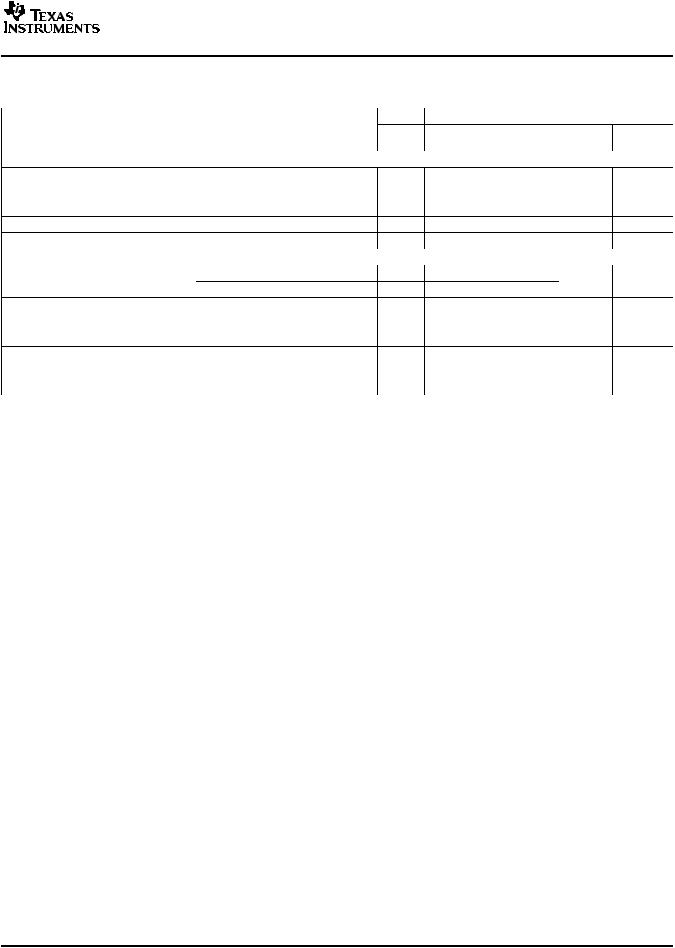
THS3110, THS3111
www.ti.com
SLOS422A –SEPTEMBER 2003 –REVISED NOVEMBER 2003
ELECTRICAL CHARACTERISTICS (continued)
VS = ±5 V, RF = 1.15 Ω, RL = 100 Ω, and G = 2 (unless otherwise noted)
|
|
TYP |
|
OVER TEMPERATURE |
|
||
PARAMETER |
TEST CONDITIONS |
25°C |
25°C |
0°C to |
-40°C to |
UNIT |
MIN/TYP/ |
|
|
70°C |
85°C |
MAX |
|||
|
|
|
|
|
|||
POWER SUPPLY |
|
|
|
|
|
|
|
Specified operating voltage |
|
±5 |
±4.5 |
±4.5 |
±4.5 |
V |
MIN |
Maximum quiescent current |
|
4 |
6 |
7 |
7 |
mA |
MAX |
Minimum quiescent current |
|
4 |
3.2 |
2 |
2 |
mA |
MIN |
Power supply rejection (+PSRR) |
VS+ = 5.5 V to 4.5 V, VS- = 5 V |
80 |
72 |
67 |
67 |
dB |
MIN |
Power supply rejection (-PSRR) |
VS+ = 5 V, VS- = -5.5 V to -4.5 V |
75 |
67 |
62 |
62 |
dB |
MIN |
POWER-DOWN CHARACTERISTICS |
|
|
|
|
|
|
|
Power-down voltage level |
Enable, REF = 0 V |
£ 0.8 |
|
|
|
V |
MAX |
Power-down , REF = 0 V |
³ 2 |
|
|
|
|||
|
|
|
|
|
|
||
Power-down quiescent current |
PD = 0 V |
200 |
450 |
500 |
500 |
µA |
MAX |
VPD quiescent current |
VPD = 0 V, REF = 0 V, |
11 |
|
|
|
µA |
TYP |
VPD = 3.3 V, REF = 0 V |
11 |
|
|
|
|||
|
|
|
|
|
|
||
Turnon time delay |
90% of final value |
4 |
|
|
|
µs |
TYP |
Turnoff time delay |
10% of final value |
6 |
|
|
|
||
|
|
|
|
|
|||
Input impedance |
|
3.4 || 1.7 |
|
|
|
kW || pF |
TYP |
7
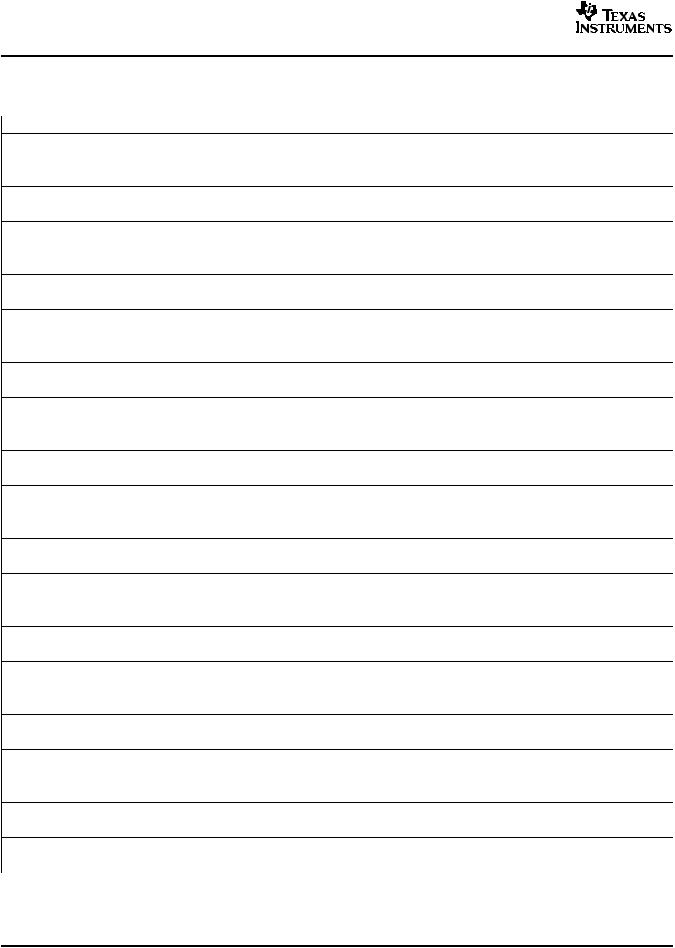
THS3110, THS3111
www.ti.com
SLOS422A –SEPTEMBER 2003 –REVISED NOVEMBER 2003
TYPICAL CHARACTERISTICS
TABLE OF GRAPHS
|
|
FIGURE |
±15-V graphs |
|
|
Noninverting small signal gain frequency response |
|
1, 2 |
Inverting small signal gain frequency response |
|
3 |
0.1 dB flatness |
|
4 |
Noninverting large signal gain frequency response |
|
5 |
Inverting large signal gain frequency response |
|
6 |
Frequency response capacitive load |
|
7 |
Recommended RISO |
vs Capacitive load |
8 |
2nd Harmonic distortion |
vs Frequency |
9 |
3rd Harmonic distortion |
vs Frequency |
10 |
Harmonic distortion |
vs Output voltage swing |
11, 12 |
Slew rate |
vs Output voltage step |
13, 14, 15, 16 |
Noise |
vs Frequency |
17 |
Settling time |
|
18, 19 |
Quiescent current |
vs Supply voltage |
20 |
Output voltage |
vs Load resistance |
21 |
Input bias and offset current |
vs Case temperature |
22 |
Input offset voltage |
vs Case temperature |
23 |
Transimpedance |
vs Frequency |
24 |
Rejection ratio |
vs Frequency |
25 |
Noninverting small signal transient response |
|
26 |
Inverting large signal transient response |
|
27 |
Overdrive recovery time |
|
28 |
Differential gain |
vs Number of loads |
29 |
Differential phase |
vs Number of loads |
30 |
Closed loop output impedance |
vs Frequency |
31 |
Power-down quiescent current |
vs Supply voltage |
32 |
Turnon and turnoff time delay |
|
33 |
±5-V graphs |
|
|
Noninverting small signal gain frequency response |
|
34 |
Inverting small signal gain frequency response |
|
35 |
0.1 dB flatness |
|
36 |
Noninverting large signal gain frequency response |
|
37 |
Inverting large signal gain frequency response |
|
38 |
Slew rate |
vs Output voltage step |
39, 40, 41, 42 |
2nd Harmonic distortion |
vs Frequency |
43 |
3rd Harmonic distortion |
vs Frequency |
44 |
Harmonic distortion |
vs Output voltage swing |
45, 46 |
Noninverting small signal transient response |
|
47 |
Inverting small signal transient response |
|
48 |
Overdrive recovery time |
|
49 |
Rejection ratio |
vs Frequency |
50 |
8
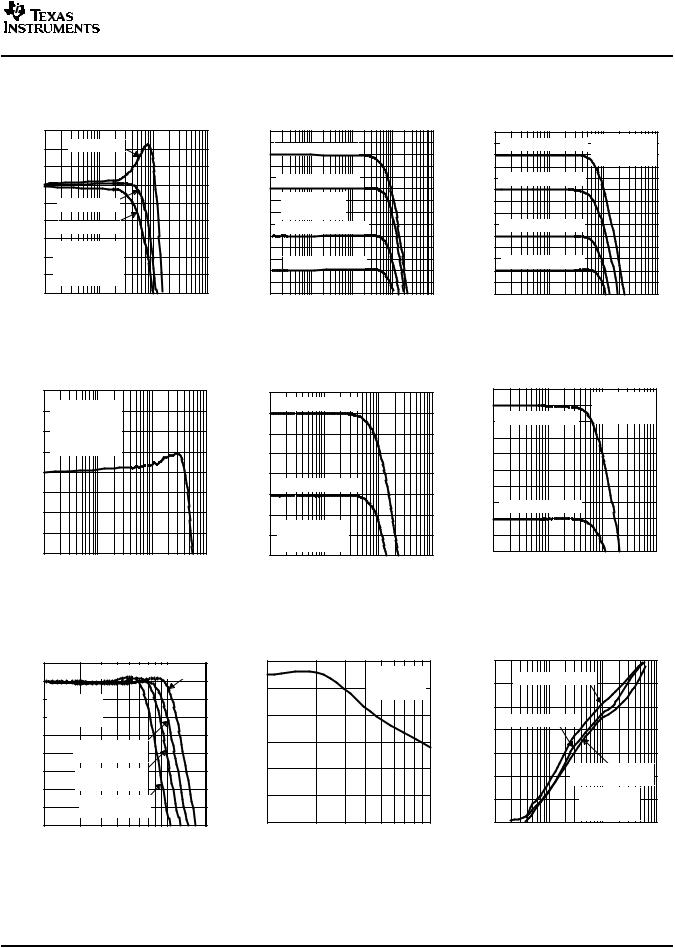
THS3110, THS3111
www.ti.com
SLOS422A –SEPTEMBER 2003 –REVISED NOVEMBER 2003
TYPICAL CHARACTERISTICS (±15 V)
NONINVERTING SMALL SIGNAL FREQUENCY RESPONSE
|
9 |
|
|
|
|
8 |
RF = 649 Ω |
|
|
|
|
|
|
|
- dB |
7 |
|
|
|
6 |
|
|
|
|
Gain |
|
|
|
|
5 |
RF = 1.15 kΩ |
|
|
|
Noninverting |
4 |
RF = 1.5 kΩ |
|
|
|
|
|
||
|
|
|
|
|
|
3 |
Gain = 2, |
|
|
|
2 |
|
|
|
|
Ω |
|
|
|
|
|
RL = 100 , |
|
|
|
1 |
VO = 0.2 VPP, |
|
|
|
VS = ±15 V |
|
|
|
|
|
|
|
|
|
0 |
|
|
|
|
1 M |
10 M |
100 M |
1 G |
|
|
f - Frequency - Hz |
|
|
Figure 1.
NONINVERTING SMALL SIGNAL
FREQUENCY RESPONSE
|
24 |
|
|
|
|
|
22 |
|
|
|
|
|
G = 10, RF = 604 Ω |
|
|
||
|
20 |
|
|
|
|
|
18 |
|
|
|
|
- dB |
16 |
G = 5, RF |
= 806 Ω |
|
dB |
14 |
|
|
|
||
Noninverting Gain |
12 |
RL = 100 Ω, |
|
Inverting Gain - |
|
|
VO = 0.2 VPP, |
|
|||
10 |
VS = ±15 V |
|
|||
8 |
G = 2, RF = 1.15 kΩ |
|
|||
6 |
|
|
|
||
4 |
|
|
|
||
2 |
G = 1, RF = 1.5 kΩ |
|
|||
|
0 |
|
|
||
|
|
|
|
|
|
|
-2 |
|
|
|
|
|
-4 |
|
|
|
|
|
100 k |
1 M |
10 M |
100 M |
1 G |
|
|
f - Frequency - Hz |
|
||
Figure 2.
INVERTING SMALL SIGNAL FREQUENCY RESPONSE
24 |
|
|
RL = 100 Ω, |
|
22 |
G = -10, RF = 649 Ω |
|
||
VO = 0.2 VPP, |
|
|||
20 |
|
|
|
|
|
|
VS = ±15 V |
|
|
18 |
|
|
|
|
|
|
|
|
|
16 |
|
G = -5, RF = 909 Ω |
|
|
14 |
|
|
|
|
12 |
|
|
|
|
10 |
|
|
|
|
8 |
G = -2, RF = 1.1 kΩ |
|
|
|
6 |
|
|
|
|
4 |
|
|
|
|
2 |
G = -1, RF = 1 kΩ |
|
|
|
0 |
|
|
|
|
-2 |
|
|
|
|
-4 |
1 M |
10 M |
100 M |
1 G |
|
||||
|
|
f - Frequency - Hz |
|
|
Figure 3.
|
NONINVERTING LARGE SIGNAL |
0.1 dB FLATNESS |
FREQUENCY RESPONSE |
|
6.4 |
|
|
|
|
16 |
|
|
|
|
6.3 |
Gain = 2, |
|
|
|
14 |
G = 5, RF = 806 Ω |
|
|
|
RF = 1.15 kΩ, |
|
|
|
|
|
|||
|
|
|
|
|
|
|
|
||
Noninverting Gain - dB |
6.2 |
RL = 100 Ω, |
|
Noninverting Gain - dB |
12 |
|
|
|
|
VO = 0.2 VPP, |
|
|
|
|
|||||
|
|
|
|
|
|
||||
6.1 |
VS = ±15 V |
|
10 |
|
|
|
|||
6 |
|
|
|
8 |
|
|
|
||
5.9 |
|
|
|
6 |
G = 2, RF = 1 kΩ |
|
|
||
|
|
|
|
|
|
||||
5.8 |
|
|
|
4 |
|
|
|
||
|
5.7 |
|
|
|
|
2 |
RL = 100 Ω, |
|
|
|
|
|
|
|
VO = 4 VPP, |
|
|
||
|
5.6 |
|
|
|
|
0 |
VS = ±15 V |
|
|
|
100 k |
1 M |
10 M |
100 M |
|
|
|
||
|
|
1 M |
10 M |
100 M |
1 G |
||||
|
|
|
f - Frequency - Hz |
|
|||||
|
|
|
|
|
f - Frequency - Hz |
|
|||
Figure 4. |
Figure 5. |
INVERTING LARGE SIGNAL
FREQUENCY RESPONSE
|
16 |
|
|
RL = 100 Ω, |
|
|
14 |
|
|
|
|
|
|
|
VO = 2 VPP, |
|
|
|
|
|
|
|
|
|
12 |
G = -5, RF = 806 Ω |
VS = ±15 V |
|
|
dB |
10 |
|
|
|
|
- |
|
|
|
|
|
Gain |
8 |
|
|
|
|
|
|
|
|
|
|
Inverting |
6 |
|
|
|
|
4 |
|
|
|
|
|
2 |
|
G =-1, RF = 1 kΩ |
|
|
|
|
|
|
|
||
|
|
|
|
|
|
|
0 |
|
|
|
|
|
-2 |
|
|
|
|
|
-4 |
|
|
|
|
|
|
1 M |
10 M |
100 M |
1 G |
|
|
|
f - Frequency - Hz |
|
|
Figure 6.
FREQUENCY RESPONSE
CAPACITIVE LOAD
|
16 |
R(ISO) = 54.9 Ω, CL = 22 pF |
||
|
14 |
|||
|
|
|
|
|
|
12 |
Gain = 5, |
|
|
dB |
10 |
RL = 100 Ω |
|
|
VS = ±15 V |
|
|
||
|
|
|
||
- |
8 |
|
|
|
Gain |
|
|
|
|
6 |
R(ISO) = 54.9 Ω |
‘ |
|
|
Signal |
CL = 10 pF |
|
|
|
4 |
R(ISO) = 39.2 Ω |
|
|
|
|
2 |
CL = 47 pF |
|
|
|
0 |
R(ISO) = 28 Ω |
|
|
|
CL = 100 pF |
|
|
|
|
|
|
|
|
|
-2 |
|
|
|
|
|
10 M |
100 M |
200 M |
Capacitive Load - MHz
Figure 7.
RECOMMENDED RISO
vs
Capacitive LOAD
|
60 |
Gain = 5, |
|
-30 |
|
|
|
|
|
|
50 |
RL = 100 Ω, |
dBc |
-40 |
|
VS = ±15 V |
|
||
Ω |
|
|
||
- |
|
|
- |
-50 |
ISO |
40 |
|
2nd Harmonic Destortion |
|
|
|
|||
|
|
|
||
Recommended R |
|
|
-60 |
|
30 |
|
|
||
|
|
-70 |
||
20 |
|
-80 |
||
|
|
|||
10 |
|
-90 |
||
|
0 |
10 |
100 |
-100 |
|
|
|
CL - Capacitive Load - pF
2nd HARMONIC DISTORTION |
|||
|
|
vs |
|
|
FREQUENCY |
|
|
|
G = 5, RF = 806 Ω |
|
|
|
G = 2, RF = 1 kΩ |
|
|
|
|
G = -2, RF = 1 kΩ |
|
|
|
RL = 1 kΩ, |
|
|
|
VO = 2 VPP, |
|
|
|
RL = 100 Ω, |
|
|
|
VS = ±15 V |
|
100 k |
1 M |
10 M |
100 M |
|
f - Frequency - Hz |
|
|
Figure 8. |
Figure 9. |
9
